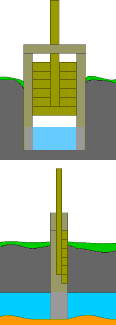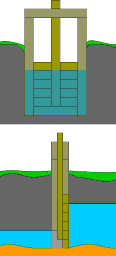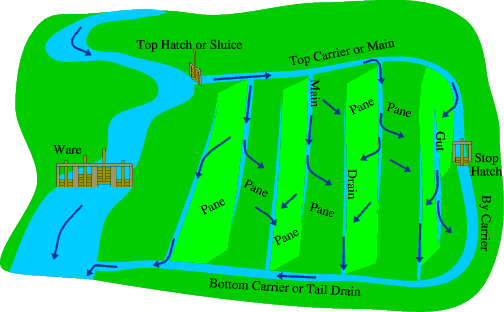| Farm-Direct |
| Quick Index |
Structure and Operation |  |
|
 Water
meadows are operated by finely tuning the levels in rivers and adjacent
carriers (artificial channels) so that a continuous trickle
of water passes over the whole area.
Water
meadows are operated by finely tuning the levels in rivers and adjacent
carriers (artificial channels) so that a continuous trickle
of water passes over the whole area.
The main channel of a suitable stream is spanned by a ware, a frame containing a number of hatches that can be raised or lowered to pen back water and raise the level sufficiently on the upstream side that some of it will follow the alternative route through the meadow. Upstream of the ware a top sluice or hatch can be raised to permit water to flow into the top carrier (or head main). After it has passed through the meadow system the water enters a bottom carrier (or tail drain) and is either returned to the river below the ware or the bottom carrier may become the top carrier for the next set of meadows downstream.
 The surface of the
meadow is not level, shallow ridges have channels along their tops called
mains, the depressions between contain drains.
The mains and drains are not connected. The mains are tapered and water
spills from them over the adjacent slopes (called panes).
In order to prevent the land becoming waterlogged the drains must have a
greater water carrying capacity than the mains and the levels must be
regulated to ensure it is carried away as fast as possible. The better
water meadows are usually found on gravelly soils which are naturally free
draining.
The surface of the
meadow is not level, shallow ridges have channels along their tops called
mains, the depressions between contain drains.
The mains and drains are not connected. The mains are tapered and water
spills from them over the adjacent slopes (called panes).
In order to prevent the land becoming waterlogged the drains must have a
greater water carrying capacity than the mains and the levels must be
regulated to ensure it is carried away as fast as possible. The better
water meadows are usually found on gravelly soils which are naturally free
draining.
Some panes are awkwardly shaped due to the natural contour of the land and occasionally a gut, an additional channel connected to neither main nor drain, is used to intercept and redistribute the flow.
In many cases a by carrier makes connection between the top carrier and the bottom carrier. When the meadow is floated (or drowned, NOT flooded, water is passing over it) the by carrier is closed by a stop hatch and very little water passes. When the meadow is 'dry' the top hatch is dropped and the stop hatch is lifted so that what water does come into the system passes straight into the bottom carrier which is kept sweet by the flow.
The system of carriers and drains acts very much like the Romney
Marsh system of drainage. Like marshland these meadows are low lying and
might naturally become boggy. The drains have a dual purpose and must be
kept open at all times to prevent stagnation.

A simplified water meadow, generally they are much larger and their shape is
dictated by the land contours. Carriers may sometimes be almost as big as
the main river channels.

Brimful, tapering mains must spill their water, slopes are arranged to
distribute the water evenly and then to drain it off once it has warmed the
soil.
It must be emphasised that, in ordinary operation water meadows are not flooded. Relatively warm river water trickles over the surface of the soil protecting the roots and growing points of the meadow grasses from frost. Flooding kills grass and waterlogging encourages rushes to grow, neither of these outcomes are desirable in a meadow.
| Farm-Direct |
| Quick Index |